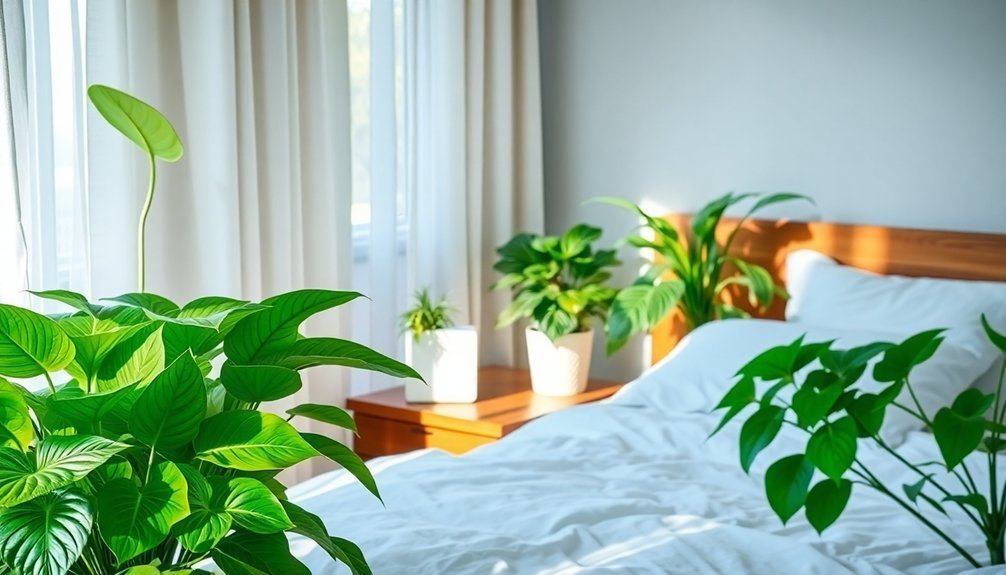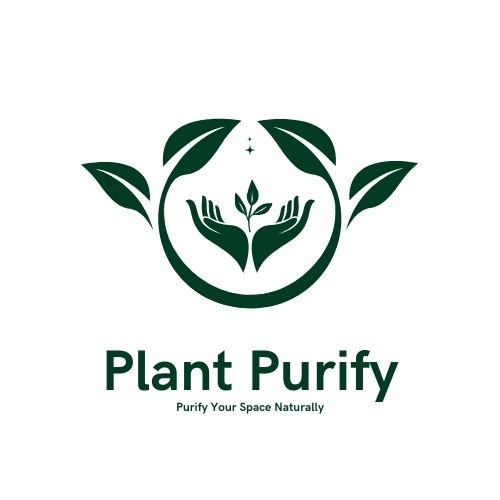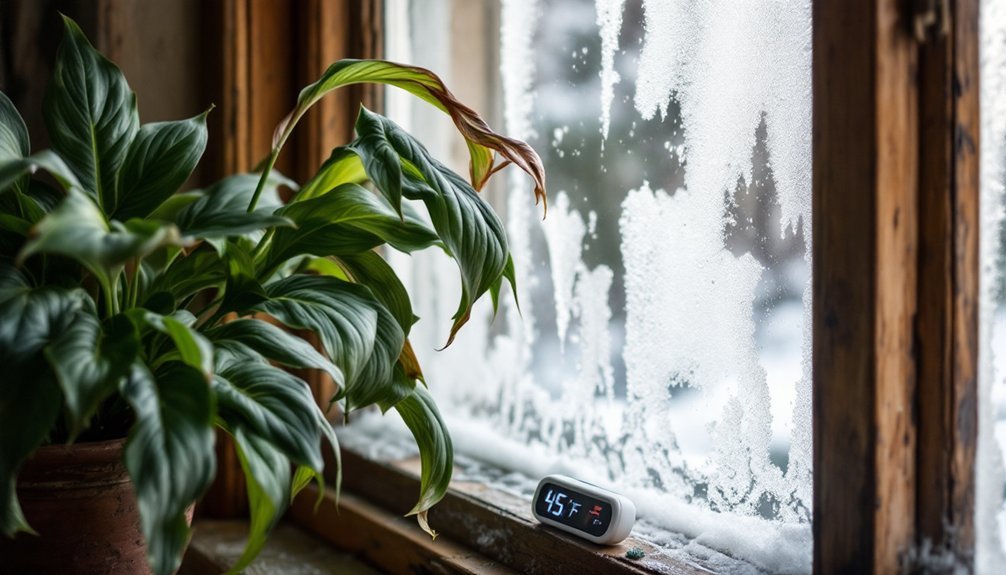Your bedroom plants naturally absorb toxic chemicals through their leaves as part of their biological processes. These chemicals, known as VOCs, come from everyday items like mattresses, paint, and cleaning products. Through photosynthesis, plants pull in these harmful compounds and, with help from beneficial microbes in their roots, transform up to 90% of pollutants into harmless substances. Understanding how this process works can help you maximize your plants' air-purifying potential.
The Science Behind Plant-Based Air Purification

While many people know that plants produce oxygen through photosynthesis, their air-purifying abilities extend far beyond this basic process.
You'll find that plants work through multiple mechanisms to clean your air. Their leaves absorb harmful pollutants like VOCs, NOx, and SO2, while their roots host beneficial microbes that break down these toxins.
When you look at a plant's transpiration process, you'll notice it creates a natural suction effect that pulls in polluted air. The plant then either stores these pollutants in its tissues or converts them into less harmful substances. Research shows plants can transform up to 90% of pollutants into sugars and new plant material.
What's fascinating is that the soil around your plant's roots plays a vital role too – it's teeming with microorganisms that transform pollutants into nutrients the plant can use for growth.
Understanding VOCs in Your Bedroom Environment
Your bedroom's air quality faces a significant challenge from Volatile Organic Compounds (VOCs), invisible chemicals that can affect both your health and sleep quality.
These toxins emanate from multiple sources you'll find in your bedroom: paints on your walls, varnishes on your furniture, and chemical treatments in your mattress and carpeting.
You're exposed to VOCs while sleeping through conventional cleaning products, air fresheners, and even your personal care items.
The health risks aren't minor – you might experience immediate effects like headaches and dizziness, while long-term exposure can lead to serious respiratory issues and organ damage.
What's particularly concerning is that these compounds continue to off-gas even after products have dried or been in place for months, making them a persistent threat to your bedroom's air quality.
Indoor VOC levels are typically 2-5 times higher than those found outdoors, making your bedroom's air quality a critical concern.
Natural Mechanisms Plants Use to Filter Air

Your bedroom plants work tirelessly through two main purification systems: leaf absorption and root microbial activity.
Through their leaves, plants absorb harmful VOCs and other pollutants directly from the air, while simultaneously releasing oxygen through photosynthesis.
The root system, along with its diverse community of soil microbes, breaks down captured pollutants and transforms them into harmless compounds, creating a natural air filtration cycle in your sleeping space. With Americans spending 90% of time indoors, having air-purifying plants in bedrooms provides a vital service for maintaining healthy indoor environments.
Leaf Absorption Process
Through an intricate network of specialized structures, plants naturally filter air pollutants using their leaves' sophisticated absorption mechanisms.
Your bedroom plant's leaves have a waxy outer layer called the cuticle that's less than 10 micrometers thick, which traps airborne particles. You'll find tiny hair-like structures called trichomes on the leaf surface that capture particulate matter, with some staying on the surface while others embed into the waxy layers.
The leaf's upper surface catches more pollutants than the bottom, thanks to its rougher texture and higher trichome density.
When you water your plants, you're washing away about 60% of these trapped particles, while the remaining 40% stay firmly embedded in the leaf's waxy coating.
Some plants, especially those with needle-like leaves, are particularly effective at filtering smaller particles from your air.
Root Microbe Filtration Systems
While leaves excel at trapping airborne particles, a plant's roots and soil harbor an equally impressive filtration system.
You'll find a complex network of microbes in the rhizosphere, the narrow region around plant roots, that actively breaks down harmful chemicals. These microscopic organisms adapt quickly to volatile organic compounds (VOCs), becoming more efficient at using them for food and energy with each generation.
Your plant cultivates these helpful microbes by secreting sugars, proteins, and vitamins around its root tips.
Through a process called the rhizophagy cycle, microbes move between the soil and root cells, transferring essential nutrients to the plant. This natural partnership is so effective that it accounts for 50-65% of VOC removal, making your bedroom plants powerful air purifiers even without their leaves doing the work.
Best Air-Purifying Plants for Your Bedroom
Selecting the right air-purifying plants for your bedroom can dramatically improve indoor air quality and create a healthier sleeping environment.
You'll find several plants that excel at removing common toxins while requiring minimal maintenance.
- Snake Plant removes five major toxins and thrives in low-light conditions
- Peace Lily increases humidity and filters out ammonia and formaldehyde
- Boston Fern acts as a natural humidifier while clearing cigarette smoke
- ZZ-Plant offers hassle-free toxin removal for busy plant owners
For best results, you'll want to combine different plants to target various pollutants.
Consider placing low-maintenance options like the Snake Plant or ZZ-Plant near your bed, while humidity-boosting plants like Peace Lilies work well on dressers or windowsills.
These natural air purifiers work continuously to cleanse your bedroom's air while you sleep.
How Root Systems Break Down Air Pollutants

Your bedroom plant's root system works as a natural filtration plant, hosting beneficial microorganisms that break down pollutants absorbed from both soil and air.
The root zone creates a mini ecosystem where bacteria and fungi transform harmful chemicals into less toxic compounds through various biochemical reactions.
You'll find this process particularly effective in plants with extensive root systems, as they provide more surface area for microbial activity and chemical breakdown.
Microbe Filtration Process
The remarkable process of microbe filtration in plants involves a sophisticated partnership between roots and beneficial microorganisms.
When you place plants in your bedroom, they're actively working to purify your air through an intricate system of absorption and breakdown.
Here's what happens in this natural filtration process:
- Plants absorb VOCs through their leaves and transport them to their root system.
- Root secretions attract and nourish helpful microbes in the rhizosphere.
- These microbes break down toxic compounds into simple sugars and nutrients.
- The plant's transpiration creates air currents that pull more pollutants to the roots.
You'll find this process is incredibly efficient, with 90% of VOCs being converted into harmless compounds like sugars, oxygen, and new plant material.
Over time, the microbes become even more effective at breaking down specific pollutants in your bedroom's air.
Root Zone Chemical Breakdown
Plant root systems perform intricate chemical processes that transform harmful air pollutants into harmless compounds through a complex network of enzymatic reactions.
When pollutants enter your bedroom's air, plant roots absorb them and initiate a series of biochemical transformations. Key enzymes like formate dehydrogenase and cytochrome P450 monooxygenase break down toxic substances such as BTEX compounds.
You'll find that benzene, for example, undergoes hydroxylation and ring cleavage, converting it into cis-cis muconic acid that enters the TCA cycle. Other pollutants are transformed into plant tissue, organic acids, or amino acids.
The root zone's effectiveness doesn't depend on photosynthesis, so your plants continue purifying air even at night. The process works best when roots have maximum air exposure and proper soil moisture levels.
Optimal Plant Placement for Maximum Air Cleaning
While achieving ideal air purification with indoor plants might seem straightforward, strategic placement plays an essential role in maximizing their effectiveness.
You'll need quite a few plants to make a measurable difference – studies show that a typical house requires hundreds of plants for significant pollutant removal.
To optimize your bedroom's air quality, consider these key placement strategies:
- Position light-loving plants like Areca Palm and Monstera near windows with bright, indirect light
- Place versatile plants like Snake Plant and ZZ Plant in darker corners where other plants won't thrive
- Guarantee proper spacing between plants to allow adequate air circulation
- Use vertical space with hanging plants like Spider Plant to maximize your room's plant capacity
Remember to factor in your room's size and environmental conditions when deciding where to position each plant.
Maintaining Your Bedroom's Air-Purifying Garden

Once you've positioned your air-purifying plants strategically, maintaining them properly becomes your next focus.
You'll need to establish a balanced watering routine, as overwatering can lead to pest problems and diminish your plants' air-cleaning effectiveness. Monitor each plant's specific light requirements, ensuring they receive appropriate exposure based on their species.
Keep an eye on temperature fluctuations and humidity levels, as these factors directly impact your plants' performance.
If you notice pests, opt for natural control methods first to avoid introducing harmful chemicals into your bedroom's air. While plants offer natural air purification, you'll achieve better results by combining them with good ventilation practices.
Remember to regularly check soil conditions and remove any dead leaves or debris that could harbor contaminants, keeping your bedroom's air-purifying garden functioning at its best.
Frequently Asked Questions
How Many Plants Are Needed per Square Foot for Effective Air Purification?
You'll need at least two large plants per 100 square feet for basic air purification, but studies show you'd actually require an impractical 10-1,000 plants per square meter for significant air cleaning effects.
Can Bedroom Plants Release Harmful Compounds During Nighttime Hours?
You don't need to worry about harmful compounds from bedroom plants at night. They release minimal CO2 that won't affect your breathing, and their air-purifying benefits far outweigh any nighttime emissions.
Do Artificial Lights Affect Plants' Ability to Purify Air?
Yes, artificial lights do reduce your plants' air-purifying abilities. When you use fluorescent lighting, your plants' photosynthetic rates decrease considerably, which limits their capacity to effectively remove pollutants from the air around you.
Which Plant Combinations Work Best Together for Maximum Air Cleaning?
You'll get the best air-cleaning results by combining Snake Plants and Peace Lilies with Spider Plants. Add Bamboo Palms and Devil's Ivy to create a powerful toxin-removing team in your space.
Does Humidity Level Impact a Plant's Ability to Filter Toxins?
Yes, humidity greatly affects your plants' toxin-filtering ability. When humidity's too high or low, your plants' stomata function improperly, reducing their capacity to absorb and filter airborne toxins through transpiration.
In Summary
Your bedroom plants don't just look pretty – they're working hard to keep your air clean through natural processes. You'll breathe easier knowing their leaves absorb VOCs while their roots break down harmful chemicals. Keep your air-purifying garden thriving by placing plants strategically around your room and maintaining proper care. With the right selection and positioning, you're creating a healthier sleeping environment naturally.
References
- https://journals.openedition.org/factsreports/6092
- https://www.lung.org/blog/houseplants-dont-clean-air
- https://www.stadlerform.com/en/health/good-air-for-allergy-sufferers/plants-as-air-purifiers-myth-or-reality
- https://time.com/5105027/indoor-plants-air-quality/
- https://transfermaster.com/blog/best-plants-for-bedroom/
- https://verbeekenbol.com/en/news/air-purifying-plants/
- https://spinoff.nasa.gov/Spinoff2019/cg_7.html
- https://eoleaf.com/pages/which-plants-purify-your-indoor-air-best
- https://ecubespace.com.sg/ways-to-manage-high-voc-levels-in-the-bedroom/
- https://massivesci.com/articles/houseplants-air-pollution-quality-vocs-indoors-nasa-study/





Leave a Reply